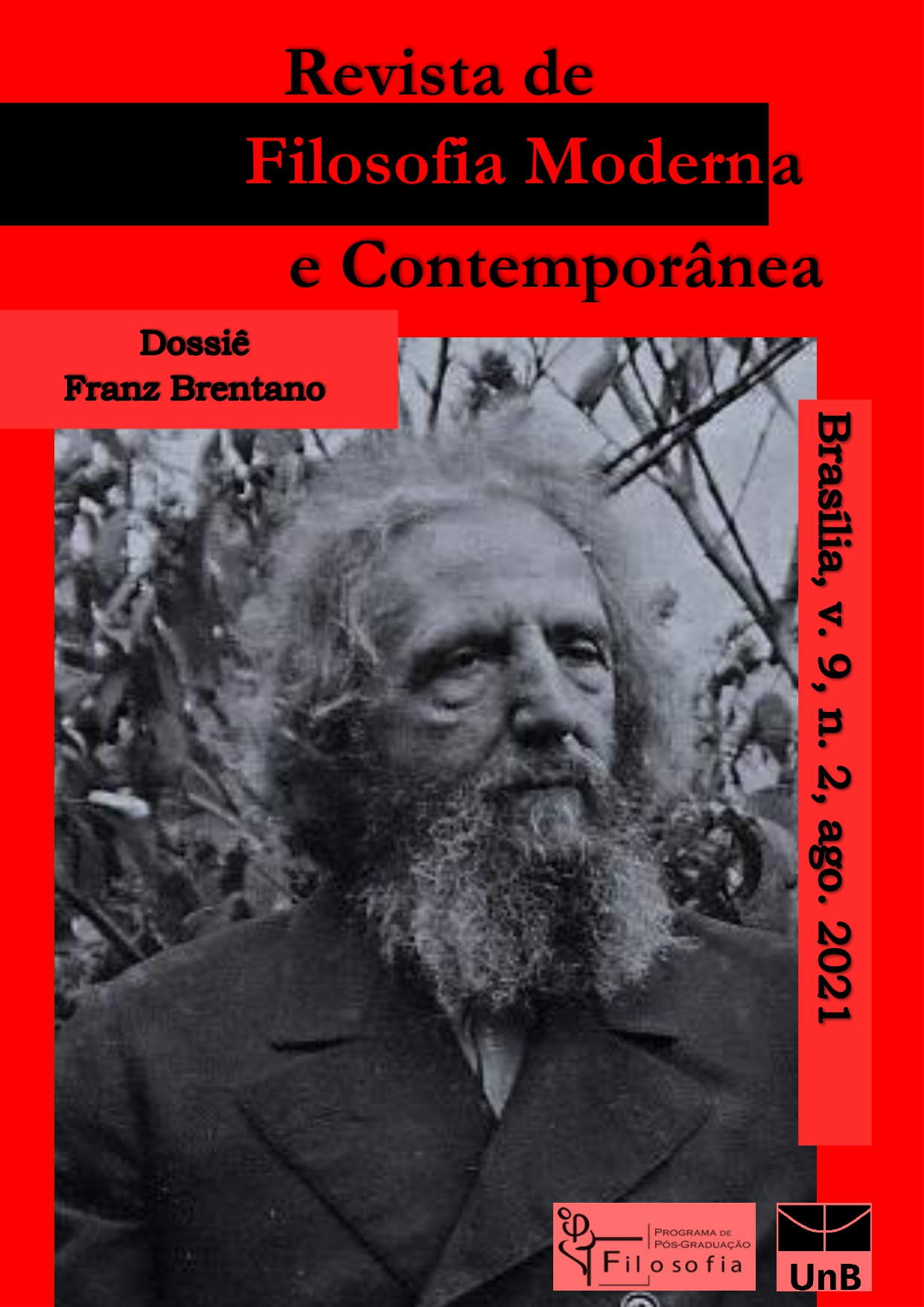On Ur-intentionality
DOI :
https://doi.org/10.26512/rfmc.v9i2.42920Mots-clés :
Ur-intentionality. Radical enactivism. Teleosemantics. Basic cognition. Content ascriptivism.Résumé
Starting from Brentano’s classical characterization of intentionality, we review the radical enactivist proposal about basic cognition and show that the underlying assumption that stripping teleosemantics of its representationalist commitments results in no explanatory loss is unwarranted. Significant features of basic cognition are lost, or so we argue, with the RECtification of teleosemantics that are retrieved by means of an alternative dubbed metaphysically non-committal content-ascriptivism.
Téléchargements
Références
BASTAKOV, V. A. “Visual illusions in Frogs and Toads”. Perception, v. 26, n. 1, suppl, pp. 80-80, 1997.
____. “Size Constancy Mechanism and Spatial Illusions in an Anuran”. Perception, v. 37, n. 1, suppl, pp. 158-158, 2008.
BRENTANO, Franz. Psychology from an Empirical Standpoint (1874). Edited by Linda L. McAlister. Translated by Antos C. Rancurello et al. New York, London: Routledge, 1995.
COLOMBO, M. “Neural Representationalism, the Hard Problem of Content and Vitiated Verdicts. A Reply to Hutto Myin (2013).” Phenomenology and the Cognitive Sciences, v. 13, n. 2, pp. 257-274, 2014.
CRANE, T. “Brentano’s Concept of Intentional Inexistence.” In: TEXTOR, M. (Ed.) The Austrian Contribution to Analytic Philosophy, London, New York: Routledge, 2006 (pp. 20-35).
____. “Intentionalism.” In: BECKERMANN, A.; McLAUGHLIN, B.; WALTER, S. (Eds.) The Oxford Handbook of Philosophy of Mind. Oxford: Oxford University Press, 2009 (pp. 474-493).
EVANS, G. The Varieties of Reference. Edited by J. H. McDowell. Oxford: Clarendon Press, 1982.
FODOR, J. A Theory of Content and Other Essays. Cambridge, MA: The MIT Press, 1990.
____. “Deconstructing Dennett’s Darwin.” Mind and Language, v. 11, n. 3, pp. 246-262, 1996.
GALLISTEL, C. R. “Symbolic Processes in the Brain: The Case of Insect Navigation”. In: SCARBOROUGH, D.; STERNBERG, S. (Eds.) An Invitation to Cognitive Science, Vol. 4: Methods, Models, and Conceptual Issues, 2nd ed., Cambridge, MA: The MIT Press, 1998.
GOZZANO, S. “The Beliefs of Mute Animals.” In: MARRAFFA, M.; DE CARO, M.; FERRETTI, F. (Eds.) Cartographies of the Mind, Dordrecht: Springer, 2007 (pp. 271-282).
GRICE, P. Studies in the Way of Words. Cambridge, MA: Harvard University Press, 1989.
HAUGELAND, J. “The Intentionality All-Stars.” Philosophical Perspectives, v. 4, pp. 383-427, 1990.
HUTTO, D. D. Folk Psychological Narratives: The Sociocultural Basis of Understanding Reasons. Cambridge, MA: The MIT Press, 2008.
____. “Philosophy of Mind’s New Lease on Life: Autopoietic Enactivism meets Teleosemiotics.” Journal of Consciousness Studies, v. 18, n. 5-6, pp. 44-64, 2011.
HUTTO, D. D.; MYIN, E. Radicalizing Enactivism: Basic Minds without Content. Cambridge, MA: The MIT Press, 2013.
____. Evolving Enactivism: Basic Minds Meet Content. Cambridge, MA: The MIT Press, 2017.
____. “Much Ado About Nothing? Why Going Non-Semantic is not Merely Semantics.” Philosophical Explorations, v. 21, n. 2, pp. 187-203, 2018.
HUTTO, D. D.; SATNE, G. “Introduction: Searching for the Natural Origins of Content.” Philosophia, v. 43, n. 3, pp. 505-519, 2015.
McCLOSKEY, M. Visual Reflections: A Perceptual Deficit and Its Implications, New York: Oxford University Press, 2009.
MIKLOSI, A. Dog Behaviour, Evolution, and Cognition. Oxford: Oxford University Press, 2007.
MILLIKAN, R. “Speaking Up for Darwin.” In: LOEWER, B.; REY, G. (Eds.) Meaning in Mind: Fodor and His Critics, Oxford: Blackwell, 1991 (pp. 151–164).
MULLER, H. D. “Naturalism and Intentionality”. In: BASHOUR, B.; MULLER, H. D. (Eds.) Contemporary Philosophical Naturalism and Its Implications, London: Routledge, 2014.
NEANDER, K. “Misrepresenting Malfunctioning.” Philosophical Studies, v. 79, n. 2, pp. 109-141, 1995.
____. A Mark of the Mental: In Defense of Informational Teleosemantics. Cambridge, MA: The MIT Press, 2017.
PIETROSKI, P. “Intentionality and Teleological Error.” Pacific Philosophical Quarterly, v. 73, n. 3, pp. 267-282, 1992.
ROY, J.-M. “Anti-Cartesianism and Anti-Brentanism: The Problem of Anti-Representationalist Intentionalism.” The Southern Journal of Philosophy, v. 53, Spindel Supplement, pp. 90–125, 2015.
SCHULTE, P. “How Frogs See the World: Putting Millikan’s Teleosemantics to the Test.” Philosophia, v. 40, n. 3, pp. 483-496, 2012.
SIEWERT, C. “Consciousness and Intentionality.” In: ZALTA, E. N. (Ed.) The Stanford Encyclopedia of Philosophy (Spring 2017 Edition), URL=https://plato.stanford.edu/archives/spr2017/entries/consciousness-intentionality/
SMITH, B. Austrian Philosophy. La Salle, IL: Open Court, 1994.
SIMONS, P. “Mind and Opacity.” Dialectica, v. 49, n. 2-4, pp. 131-146, 1995.
THOMPSON, E. “Review of Daniel D. Hutto and Erik Mying, Evolving Enactivism: Basic Minds Meet Content.” Notre Dame Philosophical Reviews, January 11, 2018.
TWARDOWSKI, K. On the Content and Object of Presentations: A Psychological Investigation (1894). Translated by Richard Grossmann. The Hague: Martinus Nijhoff, 1977.
Téléchargements
Publié-e
Comment citer
Numéro
Rubrique
Licence
(c) Tous droits réservés Journal of Modern and Contemporary Philosophy 2021

Cette œuvre est sous licence Creative Commons Attribution - Pas d'Utilisation Commerciale - Pas de Modification 4.0 International.
Direitos Autorais para artigos publicados nesta revista são do autor, com direitos da primeira publicação para a revista. Em virtude dos artigos aparecerem nesta revista de acesso público, os artigos são de uso gratuito, com atribuições próprias, em aplicações educacionais e não-comerciais.


